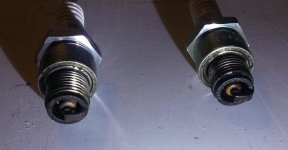I am afraid I might have been badly ripped off on a 98 Nissan Ns15d2 motor that I just bought used. I just took the boat out to the lake yesterday and the engine starts up fine, first pull usually, idles OK, maybe a little rough, but when I try to go if I give it gas to fast or just trying to go full throttle it would bog down and die. The problem seemed to get worse through the day. Both Spark plugs looked good at the beginning of the day, by the end the bottom one was wet and pretty dark the top was brown and dry. I've done a compression test on it and it seems good to me 110 and 112. Gone through the fuel lines up to the full pump and they are all clear the filter is clean. Took the carb off and it was very clean inside so I think the previous owner had rebuilt it to try to fix the problem, fuel pump diaphragm looked good as well. Tried starting it up and disconnecting the plug wires one at a time and it wouldn't run with either plug disconnected. I also tried replacing the plugs, and that didn't help. I'm a little stumped about what the problem could be at this point. Does anyone have any ideas about what else I can check?
Home
Outboard Motor Parts
Chrysler outboard parts Evinrude outboard parts Force outboard parts Honda outboard parts Johnson outboard parts Mariner outboard parts Mercury outboard parts Suzuki outboard parts Tohatsu outboard parts Yamaha outboard partsInboard & Sterndrive Engine Parts
Chrysler Marine inboard parts Crusader Marine parts MerCruiser sterndrive parts OMC sterndrive parts Pleasurecraft Marine parts Volvo Penta marine parts + MoreAll Engine Brands
All Manuals HomeOutboard Repair Manuals
Chrysler outboard manuals Evinrude outboard manuals Force outboard manuals Honda outboard manuals Johnson outboard manuals Mariner outboard manualsMercury outboard manuals Nissan outboard manuals Suzuki outboard manuals Tohatsu outboard manuals Yamaha outboard manuals
Inboard & Sterndrive Engine Manuals
MerCruiser sterndrive manuals OMC sterndrive manuals Volvo Penta marine engine manualsPlease Note
MarineEngine.com does not offer troubleshooting assistance or repair advice by email or by telephone.
You are invited to join our public Boat Repair Forum to seek assistance from other members.
You may also visit the Boat Motor Manuals section of our site to obtain a service manual.


